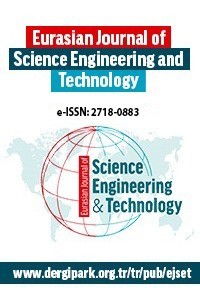SYNTHESIS AND SPECTROSCOPIC CHARACTERIZATION OF BIDENTATE SCHIFF BASE AND ZINC(II) COMPLEX
SYNTHESIS AND SPECTROSCOPIC CHARACTERIZATION OF BIDENTATE SCHIFF BASE AND ZINC(II) COMPLEX
___
- REFERENCES [1] H. Schiff, “Untersuchungen über salicinderivate,” Annalen der Chem. Vol. 150, no. 2, Feb., pp. 193-200, 1869.
- [2] J. Y. Al-Humaidi, “In situ alkaline media: Synthesis, spectroscopic, morphology and anticancer assignments of some transition metal ion complexes of 1-((2-aminophenylimino) methyl) naphthalen-2-ol Schiff base,” Journal of Molecular Structure, vol. 1183, May., pp. 190-201, 2019.
- [3] R. Reddy, Trivedi, B. S. Kumar, K. Sirisha, A.V. Sarma, B. Sridhar, and R. S. Prakasham, “Synthesis, characterization and antimicrobial activity of novel Schiff base tethered boronate esters of 1,2-O-isopropylidene-α-D-xylofuranose,” Bioorg. Med. Chem. Lett. Vol. 26, no.15, Aug., pp. 3447-3452, 2016.
- [4] I. Gönül, M. Köse, G. Ceyhan, and S. Serin, “Methoxy group containing bidentate Schiff base ligands and their transition metal complexes: Synthesis, structural characterization, photoluminescence, antioxidant capacity and superoxide dismutase activity studies,” Inorganica Chimica Acta, vol. 453, Nov., pp. 522-530, 2016.
- [5] M. Mokhles, “Spectroscopic Characterization of Some Tetradentate Schiff Bases and Their Complexes with Nickel, Copper and Zinc,” Journal of the Chinese Chemical Society, vol. 48, no. 2, Apr., pp. 153-158, 2001.
- [6] M. Kumar, S. Roy, M. S. H. Faizi, S. Kumar, M. K. Singh, S. Kishor, S. C. Peter, and R. P. John, “Synthesis, crystal structure and luminescence properties of acenaphthene benzohydrazide based ligand and its zinc (II) complex.” Journal of Molecular Structure, vol. 1128, Jan., pp. 195-204, 2017.
- [7] S. Ucan, A. Öztürk, N. Sarıkavaklı, and T. Hökelek, “4-Methoxy-2-[(E)-(phenylimino) methyl] phenol. Acta Crystallographica Section E: Structure Reports Online, vol. 64, no. 9, Sep., pp. o1818-o1819, 2008.
- [8] S. Y. Ucan, “Synthesis, spectral, thermal, and magnetic studies of cobalt (II), nickel (II), copper (II), zinc (II), and cadmium (II) complexes with N2O2 donor groups,” Russian Journal of General Chemistry, vol. 84, no. 9, Oct., pp. 1819-1824, 2014.
- [9] A. Kakanejadifard, F. Esna-ashari, P. Hashemi, and A. Zabardasti, “Synthesis and characterization of an azo dibenzoic acid Schiff base and its Ni (II), Pb (II), Zn (II) and Cd (II) complexes,” Spectrochimica Acta Part A: Molecular and Biomolecular Spectroscopy, vol. 106, Apr., pp. 80-85, 2013.
- [10] M. Khorshidifard, H. Amirirudbari, B. Banafshe Askari, M. Mehdisahihi, M. Riahifarsani, F. Faribajalilian, and G. Giuseppebruno, “Cobalt(II), Copper(II), Zinc(II) and Palladium(II) Schiff Base Complexes: Synthesis, Characterization and Catalytic Performance in Selective Oxidation of Sulfides Using Hydrogen Peroxide under Solvent-Free Conditions,” Polyhedron, vol. 95, Apr., pp. 1-13, 2015.
- [11] M. Mohammadikish, “Green synthesis and growth mechanism of new nanomaterial: Zn(salen) nano-complex,” Journal of Crystal Growth, vol. 431, Dec., pp. 39-48, 2015.
- [12] J. C. Pessoa, and I. Correia, “Salan vs. salen metal complexes in catalysis and medicinal applications: Virtues and pitfalls,” Coordination Chemistry Reviews, vol. 388, Jun., pp. 227-247, 2019.
- [13] B. Hamide, Gr. Gholamhossein, E. Vaclav, D. Michal, and D. K. Aliakbar, “Copper (II), nickel (II), zinc (II) and vanadium (IV) Schiff base complexes: Synthesis, characterization, crystal structure determination, and thermal studies,” Polyhedron, vol. 146, May., pp. 19-25, 2018.
- [14] T. N. Rahmouni, N. H. Bensiradj, S. A. Megatli, S. Djebbar, and O. B. Baitich, “New mixed amino acids complexes of iron (III) and zinc (II) with isonitrosoacetophenone: Synthesis, spectral characterization, DFT study and anticancer activity,” Spectrochimica Acta Part A: Molecular and Biomolecular Spectroscopy, vol. 213, Apr., pp. 235-248, 2019.
- [15] B. Mohan, A. Jana, N. Das, S. Bharti, and M. Choudhary, “Syntheses, crystal structures, antioxidant SOD-like properties and in-vitro antimicrobial studies of Cu (II) and Ni (II) complexes with 2-((E)-(4-bromo-2-chloro-phenylimino) methyl)-6-bromo-4-nitrophenol and (E)-1-(3,5-dichloro-2-hydroxybenzylidene)-4, 4-dimethylthiosemi-carbazide,” Journal of Molecular Structure, vol. 1171, Nov., pp. 94-109, 2018.
- Yayın Aralığı: Yılda 2 Sayı
- Başlangıç: 2020
- Yayıncı: Niğde Ömer Halisdemir Üniversitesi
4-NAPHTHYL-3-THIOSEMICARBAZIDE AS CORROSION INHIBITOR FOR COPPER IN SEA WATER (3.5% SODUIM CHLORIDE)
Mothana Ghazı Kadhım ALFALAH, Mohammed ABDULRAZZAQ, Murat SARAÇOĞLU, Fatma KANDEMİRLİ
ON THE STABILITY OF A PARTIALLY IONIZED PLASMA
Murat BARUT, Sung-yoon JUNG, Chris MI
LabVIEW BASED TEMPERATURE CONTROL SYSTEM FOR NEONATAL INCUBATOR
Zaid AL-SAWAFF, Yahya Z. YAHYA, Fatma KANDEMİRLİ
Ausnain NAVEED, Şahin SÖNMEZ, Saffet AYASUN
Yusuf KAPLAN, Gülizar Gizem ÜNALDI
SYNTHESIS AND SPECTROSCOPIC CHARACTERIZATION OF BIDENTATE SCHIFF BASE AND ZINC(II) COMPLEX
